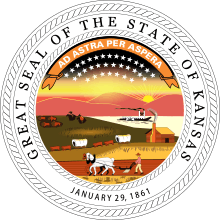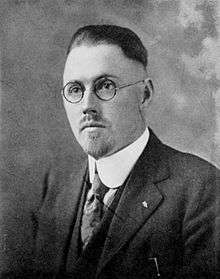1930 Kansas gubernatorial election
The 1930 Kansas gubernatorial election took place on November 4, 1930. Harry H. Woodring was elected Governor of Kansas, becoming only the fourth member of the Democratic Party to hold the position in state history. He won with only 34.96% of the vote, with the remainder being split between Republican candidate Frank Haucke and independent write-in candidate John R. Brinkley. Woodring's final margin of victory over Haucke was just 251 votes, or 0.04 percent. The incumbent governor, Republican Clyde M. Reed, did not stand for re-election.[1]
| |||||||||||||||||||||
| |||||||||||||||||||||
 Results by county
Woodring: 30-39% 40-49% 50-59% 60-69% Haucke: 30-39% 40-49% 50-59% Brinkley: 30-39% 40-49% 50-59% | |||||||||||||||||||||
| |||||||||||||||||||||
| Elections in Kansas | ||||||||||
|---|---|---|---|---|---|---|---|---|---|---|
 | ||||||||||
|
||||||||||
|
||||||||||
|
Ballot measures
|
||||||||||
Campaign and voting controversy
After losing his medical and broadcast licenses, "goat-gland doctor" John R. Brinkley decided to run for governor, a position that would enable him to appoint his own members to the medical board and thus regain his right to practice medicine. He began his candidacy in September 1930, just three days after he lost his medical license. He used his radio station to help his campaign, including recruiting a country music star to campaign for him. He also made use of several other publicity stunts. Brinkley campaigned on a vague program that included public works (a state lake in every county), education (free textbooks for public schoolchildren and increased educational opportunities for African Americans), lower taxes, and old-age pensions.[2]
| External image | |
|---|---|
Because Brinkley announced his campaign so late, he had to run as a write-in candidate. Three days before the election, the Attorney General of Kansas (a known opponent) announced that the rules surrounding write-in candidates had changed, and that Brinkley's name could only be written in in one specific way for the vote to count (as "J. R. Brinkley").[3] An article published at the time in The Des Moines Register estimated that between 30,000 and 50,000 ballots were disqualified in this manner.[2] The successful candidate, Woodring, later admitted he would have lost had all of Brinkley's votes been counted.[4]
Results
Woodring won 39 counties (including Rawlins County by a single vote), Haucke won 38 counties, and Brinkley 28 counties.
| Party | Candidate | Votes | % | ± | |
|---|---|---|---|---|---|
| Democratic | Harry H. Woodring | 217,171 | 34.96% | +1.76 | |
| Republican | Frank Haucke | 216,920 | 34.92% | –30.68 | |
| Independent | John R. Brinkley (write-in) | 183,278 | 29.50% | +29.50 | |
| Socialist | J. B. Shields | 3,866 | 0.62% | –0.58% | |
| Majority | 251 | 0.04% | N/A | ||
| Democratic gain from Republican | Swing | 1.76% | |||
References
- Kansas 1930
- Brock, Pope. Charlatan: America's Most Dangerous Huckster, the Man Who Pursued Him, and the Age of Flimflam, Crown Publishing. 2008. ISBN 0-307-33988-2
- "POLITICAL NOTES: Capric Candidate". Time Magazine. October 17, 1932. Retrieved 2010-06-17.
Two years ago Governor Woodring squeezed into office with a majority of 319 votes. John Brinkley, his name not on the ballot, polled close to the leaders with 188,000 votes.
- Lee, R. Alton (2002). The Bizarre Careers of John R. Brinkley. University Press of Kentucky. pp. 127–129. ISBN 0-8131-2232-5. Retrieved May 6, 2017.


